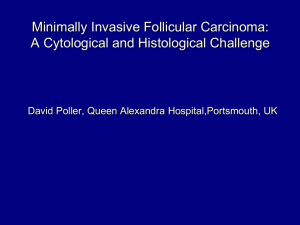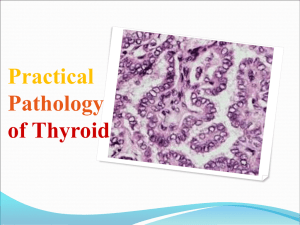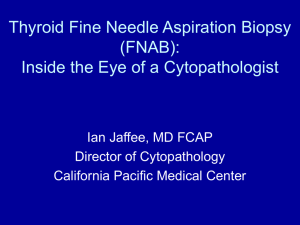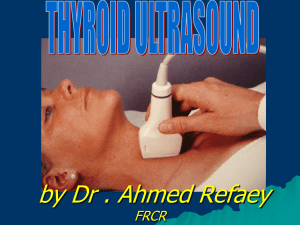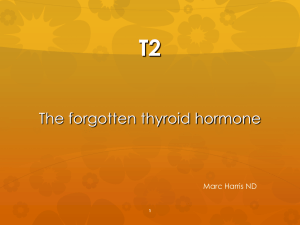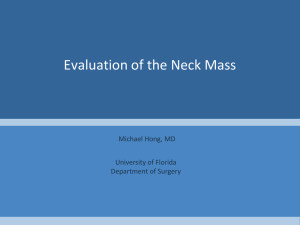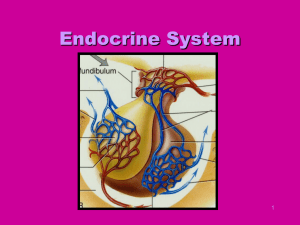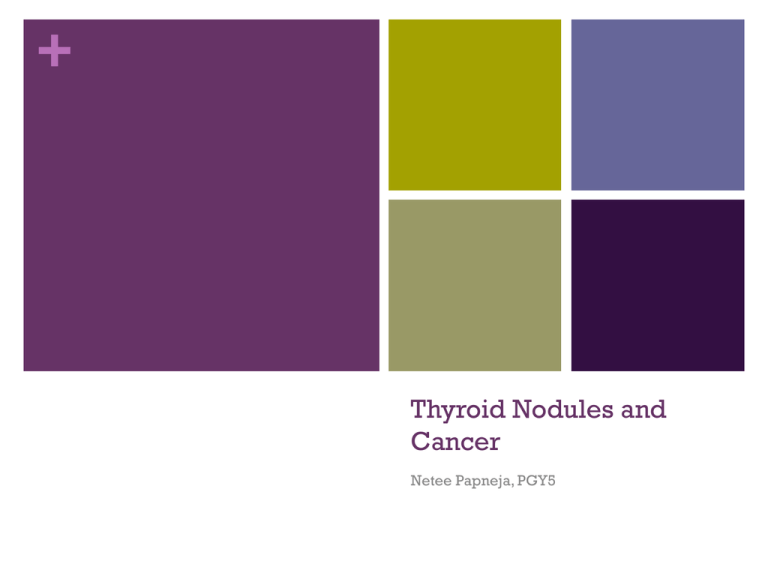
+
Thyroid Nodules and
Cancer
Netee Papneja, PGY5
+
Objectives
Review
Epidemiology of thyroid nodules/cancers
Approach to thyroid nodules
Newer evidence re: indications for biopsy
Molecular characterization of FNA results
Thyroid cancer guidelines
+
Epidemiology
Thyroid nodules are very common
Palpable nodules
5% of women
1% of men
Ultrasound series
19-67%
Autopsy series
37-57%
The prevalence of nodules increases with age
Prevalence in women 1.5-1.7 times higher than men
ATA guidelines 2009
+
Etiology of Benign Nodules
Focal thyroiditis
Benign adenomas – follicular and hurthle cell
Thyroid, parathyroid, thyroglossal cysts
Post surgical/radiation remnant hyperplasia
Rare: teratoma, lipoma, hemangioma
+
Thyroid Nodules
Thyroid cancer which occurs in 5–15% of nodules
Type
Frequency
Prognosis
PTC
80%
30-year survival 95%
Follicular (including Hurthle
cell)
10%
30-year survival 85%
Medullary
5%
10-year survival 65%
Anaplastic
3%
5-year survival 5%
Miscellaneous (lymphoma,
fibrosarcoma, SCC, teratomas,
metastatic carcinomas)
1%
+
Thyroid Cancer – Incidence
Incidence of thyroid cancer is increasing
1973: 3.6 per 100,000
2009: 8.7 per 100,000
However, mortality rates have stayed the same
? due to actual increase in incidence or increased detection
Socioeconomic status and increased access to healthcare
resources are associated with higher rates of papillary thyroid
cancer (US, Canada)
+
Thyroid Cancer - Incidence
Aim:
examined whether the density of endocrinologists and general
surgeons use of US were factors associated with increased incidence
of thyroid cancer
Methods:
compared incidence data from SEER database (National Cancer
Institute's Surveillance Epidemiology and End Results) from 1999 to
2009 with the density of endocrinologists and general surgeons
Udelsman,R.&Zhang,Y.Theepidemicof thyroid cancer in the United States:
the role of endocrinologists and ultrasounds. Thyroid http://dx.doi.org/10.1089/thy.2013.
+
Results: The incidence rates were significantly correlated with
the density of endocrinologists (r=0.58, p<0.0001 for males;
r=0.44, p=0.0031 for females) and the employment of cervical
ultrasonography (r=0.40, p=0.0091 for males; r=0.36, p=0.0197 for
females).
Conclusions:
~ 50% of the DTC epidemic could be explained by
‘overdiagnosis’
50% - radiation exposure due to increased use of neck CT
scans, chemical exposure and/or obesity
Udelsman,R.&Zhang,Y.Theepidemicof thyroid cancer in the United States:
the role of endocrinologists and ultrasounds. Thyroid http://dx.doi.org/10.1089/thy.2013.
+
Thyroid Cancer Risk Factors
Extremes of Age
Thyroid nodules in children are twice as likely to be malignant
In adults, higher rate of malignancy if age > 60
Sex
Malignancy rate 2x higher in men compared to women (8% vs 4%)
Family history
FHx of a thyroid cancer syndrome (eg, familial polyposis, Carney
Complex, MEN type 2)
10-fold increased risk of thyroid cancer in first degree relatives of thyroid
cancer patients
Uptodate: ‘’Overview of thyroid nodule formation’’
+
Thyroid Cancer Risk Factors
Clinical signs —
rapid growth, fixation of the nodule to surrounding tissues, new
onset hoarseness or vocal cord paralysis, or the presence of
ipsilateral cervical lymphadenopathy
Radiation Explosure
most important RF = radiation exposure during childhood
~25% have thyroid nodules
~33% have malignant nodules
No evidence that radiation-associated thyroid cancers are more
aggressive than other thyroid cancers
+
Thyroid cancer risk factors
Radiation exposure - potential sources:
medical uses of radiation (eg, childhood malignancies)
atomic weapons (eg, Nagasaki/Hiroshima, Japan 1945), or nuclear
power plant accidents (eg, Chernobyl 1986, Fukushima Daiichi
nuclear disaster 2011)
ionizing radiation to treat benign conditions of the head and neck
in 1950s
+
Investigations
+
Investigations
Laboratory tests
Serum TSH
If low radionuclide thyroid scan
Either 123I or 99mTc pertechnetate
Otherwise Further evaluation for possible FNA
TSH level correlates to risk of thyroid cancer
+
Thyroid Cancer and TSH
TSH (mU/L)
< 0.4
Prevalence of thyroid cancer
(%)
2.8%
0.4 – 0.9
3.7%
1.0 – 1.7
8.4%
1.8 – 5.5
12.3%
> 5.5
29.7%
Boelaert K, Horacek J, Holder RL, et al. Serum thyrotropin concentration as a novel
predictor of malignancy in thyroid nodules investigated by fine-needle aspiration.
J Clin Endocrinol Metab 2006; 91:4295.
+
Investigations
Laboratory tests
Serum thyroglobulin (Tg)
Can be elevated in most thyroid diseases
Insensitive and nonspecific test for thyroid cancer
Not recommended as part of the initial evaluation
+
Investigations
Serum calcitonin
Screening with calcitonin may detect MTC at an earlier stage (likely
present if level > 100 pg/mL)
But also detects C-cell hyperplasia and micromedullary carcinoma
(clinical significance uncertain)
ATA: Cannot recommend either for or against routine measurement
False-positive results:
hypercalcemia, hypergastrinemia, neuroendocrine tumors, renal
insufficiency, papillary and follicular thyroid carcinomas, goiter, and
chronic autoimmune thyroiditis
prolonged treatment with omeprazole (greater than two to four
months), beta-blockers, and glucocorticoids
+
Ultrasound
High Risk Features
Low Risk Features
Hypoechoic
Hyperechoic
Increased central vascularity
Peripheral vascularity
Incomplete halo
Complete Halo
Microcalcifications
Comet-tail
Irregular borders
Large, coarse calcifications
Taller than wide (transverse
view)
Suspicious lymph nodes
+
Central Vascularity
+ Microcalcifications
+
Irregular Borders
+
Taller Than Wide
+
Comet-tail Artifact
+
Investigations
Fine-needle aspiration (FNA)
Most accurate and cost effective
Sensitivity 76-98%, specificity 71-100%
Prior to FNA, only 15% of resected nodules were malignant
With FNA, malignancy rate of resected nodules > 50%
False positive and non-diagnostic cytology rates lowered with US
guidance
ATA
FNA
Indications
+
High-risk history: History of thyroid cancer in first degree relatives; external beam radiation as a
child; exposure to ionizing radiation in childhood or adolescence; prior hemithyroidectomy with
discovery of thyroid cancer, 18FDG avidity on PET scanning; MEN2=FMTC-associated RET
protooncogene mutation, calcitonin >100 pg=mL.
Suspicious features: microcalcifications; hypoechoic; increased nodular vascularity; infiltrative
margins; taller than wide on transverse view.
+ Diagnostic Accuracy of the Ultrasonographic Features for
Subcentimeter Thyroid Nodules Suggested by the Revised ATA
Guidelines
KIM ET AL, THYROID, Volume 23, Number 12, September 2013
Purpose: To analyze the diagnostic performance of the ATA
guidelines and compared it to that of other modified
guidelines.
Methods:
713 nodules 6-10mm (Yonsei University , Korea)
Frequencies of US features in benign and malignant nodules were
compared
Seven modified guidelines were made based on the revised ATA
guidelines and from multi- variate analysis results
+
Modified guidelines
1.
excluded ‘‘increased nodular vascularity’’
2.
included composition criteria and only solid nodules were
considered
3.
excluded the increased nodular vascularity and included solid
4.
included macrocalcification
5.
included macrocalcification and excluded ‘‘increased nodular
vascularity’’
6.
included macrocalcification and only solids
7.
Included macrocalcifications and excluded increased nodular
vascularity
+
Results
Solid composition and macrocalcification were significantly
associated with malignancy (p=0.001 and 0.003).
Increased vascularity was not significantly associated with malignant
nodules (odds ratio 0.729, p = 0.212).
Among the eight guidelines, the ATA guidelines showed the lowest
diagnostic performance (Az = 0.616).
Excluding increased vascuarity and including solid composition +/macrocalcification to the suspicious US features of the ATA guidelines
improved sensitivity (96.6% vs. 97.0%), specificity (26.6% vs. 42.9%),
PPV (48.3% vs. 54.7%), and NPV (91.7% vs. 95.2%), thereby resulting
in the highest Az value (diagnostic performance) (Az = 0.699, p <
0.001)
+
Conclusions:
This study suggests that excluding increased vascularity and
adding solid composition to the suspicious ultrasonographic
features of the ATA guidelines would significantly improve the
diagnostic performance in subcentimeter nodules for the
identification of malignant lesions.
+
Risk of Thyroid Cancer Based on Thyroid Ultrasound Imaging
Characteristics
Results of a Population-Based Study
Rebecca Smith-Bindman, MD; Paulette Lebda, MD; Vickie A. Feldstein, MD; Dorra
Sellami, MD; Ruth B. Goldstein, MD; Natasha Brasic, MD; Chengshi Jin, PhD; John
Kornak, PhD
JAMA Intern Med. Published online August 26, 2013
+ Risk of Thyroid Cancer Based on Thyroid
Ultrasound Imaging Characteristics
Retrospective case control study
8,806 patients with 11,618 thyroid US at a UCSF facility from
January 2000 - March 2005.
patients did not have a diagnosis of thyroid cancer at the time of
US
They linked the patients with the California Cancer Registry and
identified 105 who were diagnosed with thyroid cancer
The cancer patients were matched with a group of cancer-free
control subjects from the same cohort, based on factors such as
gender, age and the year of the ultrasound exam
+ Results:
Only 3 US nodule characteristics were associated with the risk of
thyroid cancer—
microcalcifications (odds ratio [OR], 8.1; 95% CI, 3.8-17.3)
size greater than 2 cm (OR, 3.6; 95% CI, 1.7-7.6)
an entirely solid composition (OR, 4.0; 95% CI, 1.7-9.2)
1 characteristic = sensitivity 88%, high false-positive rate 44%, a low
positive likelihood ratio of 2.0 and 56 biopsies will be performed per
cancer diagnosed.
2 characteristics = sensitivity 52%, FPR 7%, the positive likelihood
ratio (7.1), and only 16 biopsies performed per cancer diagnosed.
+
Conclusions:
Using only + microcalcifications or combination of both >2cm AND
solid as indications for biopsy, estimated risk of cancer in those not
biopsied is only ~0.5%
May reduce unnecessary biopsies by 90%
20 year survival of DTC is >97%
Ongoing surveillance is unlikely to be beneficial as risk for cancer
remains low at 10 years
** Doesn’t take into account lymphadenopathy, invasion beyond
thyoird capsule, fHx of Thyroid cancer, or radiation history; was a
retrospective study
+
Fine Needle Aspiration:
Results
+
Investigations: FNA
Risk of cancer
(%)
Usual managment
0-3%
Clinical f/u
Follicular lesion or atypia of
undetermined significance
5-15%
Repeat FNA
Follicular Neoplasm
15-30%
Lobectomy
Suspicious for malignancy
60-75%
Thyroidectomy or
lobectomy
Non diagnostic
1-4%
Repeat FNA -US
Malignant
97-99%
Thyroidectomy
Benign
+
Management of Indeterminate FNA
10%
to 40% of FNA specimens are cytologically
indeterminate.
Indeterminate results = Follicular Lesion of Undetermined
Significance (FLUS)/Atypia of Undetermined Significance (AUS)
and (suspicious for) Hürthle/Follicular Neoplasm
Risk
of malignancy:
FLUS/Atypia: 5-15%
Follicular Neoplasm: 15-30%
+
FNA – indeterminate results
Repeat
FNA with ultrasound guidance
Satisfactory specimen in 75% of solid nodules
Satisfactory specimen in 50% of cystic nodules
On-site
cytologic evaluation may improve yield
7% of nodules continue to be nondiagnostic (and
may still be malignant)
75
to 95 % of patients undergo surgery for what is
ultimately confirmed to be benign
increased morbidity, operative risk, and excess
cost
+
FNA – indeterminate results
Improvement in the assessment of indeterminate FNA results may
allow better risk stratification
ATA: Recommendation C - Can consider molecular markers to
help guide management
e.g. BRAF, RAS, RET/PTC, Pax8-PPAR-gamma, or galectin-3
+
Molecular Markers
Two
approaches to the molecular
characterization of FNA results that are
commercially available in the United States:
identification
of particular molecular markers of
malignancy, such as BRAF and RAS mutational status
Use of high density genomic data for molecular
classification (an FNA-trained mRNA classifier)
+
Veracyte Afirma Gene Classifier
GEC assesses gene expression from mRNA from needle
washings during a standard FNA procedure
Gene expression is compared against 167 genes Veracyte has
previously identified as characteristic of benign and malignant
nodules
Reports the nodule as benign or suspicious
Intended as a rule-out test
Analysis most effective in identifying lesions with indeterminate
cytology that are highly likely to be benign, therefore avoiding
surgery
THYROID. Volume 23, Number 2, 2013
+
Clinical Validity of the
Afirma Gene Expression Classifier
A
large, multi-center (49 sites - 35%
academic / 65% community), prospective
clinical validation study published in NEJM
in 2012
“Double-blind” design
patients
and physicians blind to molecular
result
Molecular lab blind to surgical pathology
diagnosis and pathologists unaware of
molecular results
-Alexander EK, et al. Preoperative Diagnosis of Benign Thyroid Nodules
with Indeterminate Cytology. N Engl J Med. 2012;367:705-715.
+
Afirma Gene Expression Classifier
Results:
For 265 cytologically indeterminate nodules
overall NPV was 93%
Sensitivity = 92% (7 of 85 cancers, 8%, were incorrectly
identified as benign)
Specificity = 52% (48% of benign nodules were incorrectly
identified as suspicious)
The risk of malignancy of a GEC benign result is comparable to
that of nodule diagnosed as benign by cytopathology (1)
1. Wang CC et al. A Large Multicenter Correlation Study of Thyroid Nodule Cytopathology and
Histopathology. Thyroid. 2011;21:243-251
+
Afirma GEC – Real life experience:
However, findings of study were obtained in a trial where
protocol and enrollment are tightly managed.
Understanding how the Afirma GEC performs in a clinical
setting remains unclear until recent study published Oct 2013
in JCEM by Erik K. Alexander
+ E. K. Alexander et al. Multicenter Clinical Experience with the
Afirma Gene Expression Classifier.
Journal of Clinical Endocrinology & Metabolism, 2013.
Methods:
analyzed all patients who had Afirma GEC testing at 5 academic
centers between 2010 –2013.
339 patients
Results analyzed for pooled test performance, impact on clinical
care, and site-to-site variation
+
Total
TOTAL
#
GEC
Benign
GEC
GEC
Suspiciou Non-Diagnostic
s
339
174 (51%) 148
(44%)
17 (5%)
6 Lost
3 Sx
2 repeat GEC
2 repeat FNA
2 repeat FNA
1 refused further testing
AUS/FLUS
165
91 (55%)
66 (40%)
8 (5%)
Follicular
Neoplasm
161
79 (49%)
73 (45%)
9 (6%)
Suspicious
for
Malignancy
13
4 (31%)
9 (69%)
0
+ Results:
148 Afirma GEC “Suspicious”
141 of 148 (95%) surgery recommended
121 of 148 (82%) surgery performed
Histopathology Malignant: 53 (44%)
•AUS/FLUS
Number
Histopathology
Malignant:
•48
•23 (48%)
-21 PTC
1 Follicular/1 other
•Follicular
Neoplasm
•65
•24 (37%)
-19 PTC
4 Follicular/1
Hurthle
•Suspicious for
Malignancy:
•8
•6 (75%)
-6 Papillary
Carcinoma
+
174 Afirma GEC “Benign”
4 of 174 surgery recommended (3 FLUS/1 SUS)
11 of 174 (6%) surgery performed
Histopathology Malignant: 1/11 = 0.6cm PTC
Initial validation study: 38% indeterminate nodules were benign,
however in this study 51% were benign GEC result
Afirma GEC testing after 1st study only recommended for AUS/ FLUS
and/or FN cytology; not suspicious.
This study 96% cyto indeterminate samples were AUS/FLUS and/or FN
explaining the increased proportion of benign GEC results.
+
Benign Afirma GEC results:
Only 71/ 174 patients (41%) had documented followup at a mean of 8.5
months following GEC testing
10/71 – clinical exam followup
61/71 – repeat US
11/71 of these patients underwent thyroid surgery (personal preference
or compressive symptoms)
10/ 11 = benign histologically
1/11 confirmed cancer (1.0cm US nodules which proved a 0.6cm PTC
histologically)
Summary: 1/71 GEC benign proved cancerous
+
Clinical Impact:
95% of Afirma GEC “suspicious” nodules were referred for thyroid
surgery in comparison to only 2% of Afirma GEC “benign” nodules
in an academic clinical setting, a 76% reduction in surgery was
observed when the Afirma GEC was applied to patients in whom
surgery would otherwise have been typically performed
+
Results:
current standard of care practice: $12,172 per patient
Using GEC: $10,719
cost savings due to: less surgeries
GEC test sensitivity was assumed to be 91%
This cost analysis states that only 1.4% of malignant nodules would be
missed by the classifier
+
The Asuragen miRInform Molecular
Panel
Panel of molecular tests used to to improve preoperative
cytological diagnostic accuracy for indeterminate thyroid
nodules
These markers are recommended by the ATA (recommendation
rating of "C”)
A rule-in method that is designed to have a high predictive
specificity; that is, a positive test is highly associated with
malignant histology.
+
The Asuragen miRInform Molecular
Panel
17 validated molecular markers to identify mutations with
strong associations with papillary and follicular thyroid
cancers
These mutations and translocations are found in up to 80% of
papillary (BRAF, RAS, RET/PTC) and 70% of follicular (RAS,
PAX8/PPARγ)
+
+
The Asuragen miRInform Molecular
Panel
It is commercially available
No published validation of this method yet
However, there is a published experience with the
noncommercial use of these markers as prospective
predictors of thyroid cancer in FNA samples from academic
centers
+
Nikiforov YE et al.
J Clin Endocrinol Metab 96:3390–3397
Objective:
to study the clinical utility of molecular testing of thyroid FNA
samples with indeterminate cytology.
Design:
material from 1056 consecutive thyroid FNA samples with
indeterminate cytology was used for prospective molecular
analysis and tested for a panel of mutations consisted of BRAF
V600E, NRAS codon 61, HRAS codon 61, and KRAS codons 12/13
point mutations and RET/PTC1, RET/PTC3, and PAX8/PPAR
rearrangements
+
Results:
Risk of malignancy based on cytology:
AUS/FLUS = 14%
FN/SFN = 27%
SMC =54%
Risk of malignancy if + for any mutations in panel:
AUS/FLUS = 88%
FN/SFN = 87%
SMC = 95%
SFN = suspicious for follicular neoplasm; SMC= suspicious for malignant cell
Nikiforov YE et al. 2011 Impact of mutational testing on the diagnosis and management of patients wit
cytologically indeterminate thyroid nodules: a prospective analysis of 1056 FNA samples. J Clin
Endocrinol Metab 96:3390–3397.
+
This method demonstrated an overall specificity of 98%.
Overall sensitivity of this method is only 60%
only 2% of benign nodules were positive for a genetic marker
6 % (of FL/AUS) and 14 % (FN) were negative for these mutations and
proved to be cancer on surgical histology
Clinical utility: Consider upfront total thyroidectomy for molecular
positive result, but initial diagnostic lobectomy is still indicated
with mutation-negative specimens
+
Costs for Molecular Panel
miRInform Thyroid panel retail price = $2250
Medicare reimbursement for this test is $650, and from
private insurers varies up to $950.
Steven P. Hodak et al. Information for Clinicians: Commercially Available Molecular Dia
Testing in the Evaluation of Thyroid Nodule Fine-Needle Aspiration Specimens
THYROID Volume 23, Number 2, 2013
+
Molecular Panel : Cost Analysis
Standard of care: $578 and molecular testing: $682
molecular testing resulted in decreased diagnostic lobectomies
(9.7% v. standard of care 11.6%) while initial total thyroidectomy
was more frequent (18.2% v. standard of care 16.1%)
molecular testing added a diagnostic cost of $5,031 to the cost of
each additional indicated total thyroidectomy bringing the total cost
to $16,414.
However, the cumulative cost was still less than the cost of a
lobectomy ($7,684) followed by completion thyroidectomy ($11,954)
in the standard-of-care cohort
In sensitivity analysis, savings were demonstrated if molecular
testing cost was less than $870
Yip L et al. 2012 Cost impact of molecular testing for indeterminate thyroid nodule
fine-needle aspiration biopsies. J Clin En- docrinol Metab 97:1905–1912.
+
Next Generation Sequencing Test
(NGST)
ThyroSeq
new method with the aim of detecting most point mutations and
small insertions or deletions known to occur in thyroid cancer
targets 12 cancer genes with 284 mutational hot spots
The test made its debut at UPMC/UPCI Multidisciplinary
Thyroid Center at the University of Pittsburgh
+
Next Generation Sequencing Test
Study published 2013
228 thyroid neoplastic and nonneoplastic specimens
assessed
Clin Thyroidol 2013;25:288–289
Next-Generation Sequencing Has Identified New Oncogenic Mutations in
Thyroid Nodules
+
Next Generation Sequencing Test
ThyroSeq DNA assay identified mutations in:
19 of 27 of PTC (70%)
25 of 30 follicular variant PTCs (83%)
3 of 10 poorly differentiated carcinomas (30%)
20 of 27 anaplastic (ATCs) (74%)
11 of 15 medullary thyroid carcinomas (73%)
5 of 83 benign nodules (6%) were positive for mutations
Clin Thyroidol 2013;25:288–289
Next-Generation Sequencing Has Identified New Oncogenic Mutations in
Thyroid Nodules
+
Next Generation Sequencing Test
Conclusions:
Allows testing for multiple mutations with high accuracy and
sensitivity
Point mutations were detected in 30% to 83% of specific types
of thyroid cancer and in only 6% of benign thyroid nodules
Discovery of uncommon mutations, such as PTEN, TP53, PI3KCA,
and TSHR. With the addition of these mutations to those of BRAF,
RAS, and the PAX8/PPARg and RET/PTC rearrangements, 80% of
thyroid cancers are now believed to have detectable mutations
+
Use Molecular Methods
Experience with these molecular methods remains limited,
and no test has perfect sensitivity and specificity.
The ATA feels that until expert consensus review of existing
data (now underway by the ATA Guidelines Task Force) can
be completed, no evidence-based recommendation for or
against the use of these methods can be made.
Clinicians are therefore advised to consider the use of these
genetic diagnosis methods with appropriate caution
+
Conclusion
Thyroid cancer incidence rates have been increasing
worldwide
?due to increased detection rates from US
No associated higher mortality
ATA guidelines may be modified to decrease frequency of
FNA done
New molecular methods for indeterminate FNA samples
seem to be promising, but not available in Canada yet
+
Questions?

